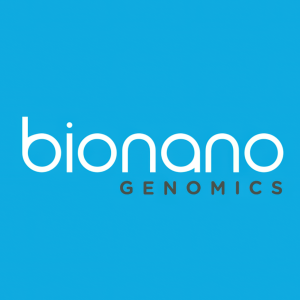Bionano Recaps Global Momentum Behind Optical Genome Mapping at the 2025 Annual Meeting of the European Society of Human Genetics Held Recently in Milan, Italy
Rhea-AI Summary
Positive
- None.
Negative
- None.
News Market Reaction 1 Alert
On the day this news was published, BNGO gained 1.84%, reflecting a mild positive market reaction.
Data tracked by StockTitan Argus on the day of publication.
SAN DIEGO, June 18, 2025 (GLOBE NEWSWIRE) -- Bionano Genomics (NASDAQ: BNGO) recently participated in the European Society of Human Genetics (ESHG) conference held in Milan, Italy, from May 24-27, 2025. The event highlighted the use of optical genome mapping (OGM) in genetic disease research, with numerous presentations and posters emphasizing its utility in detecting structural variants (SVs) associated with genetic diseases – including constitutional disorders, hematological malignancies and solid tumors.
Key Highlights from ESHG 2025:
Scientific Presentations and Posters: A total of 21 studies with authors representing 12 different countries were presented – either oral presentations or posters – demonstrating the effectiveness of OGM in identifying SVs that can often be missed by traditional cytogenetic and sequencing methods. These findings underscore OGM's potential for addressing complex, unresolved genetic conditions.
| Talk/ Poster | Title | Author | Institution |
| C01.06 | Gene-pseudogene inversions as a source of missing heritability | Stefano Facchini | University College London, United Kingdom Università di Pavia, Italy |
| W05.4 | Mobile element insertions in disease: an overlooked diagnostic challenge | Robin Wijngaard | Radboud University Medical Center, Netherlands |
| P01.073.A | Uncovering novel structural variants in pediatric low grade gliomas | Miriam Bornhorst | Ann & Robert Lurie Children's Hospital of Chicago, USA |
| P14.009.A | Cohort of 90 patients mainly affected by neurodevelopmental delay analyzed using optical genome mapping (OMG) technique in constitutional cytogenomics | Stephane Bezieau | CHU Nantes, France |
| P14.017.A | Breakpoint mapping in balanced chromosomal rearrangements allows insights into the molecular underpinnings of rare diseases | Michael Wendel Da Silva | Universidade Federal de São Paulo, Brazil |
| P01.006.B | Optical Genome Mapping in hematological malignancies: is it time for conventional cytogenetic approaches to stand aside? | Chiara Mongodi | Laboratory of Medical Genetics, ASST Papa Giovanni XXIII, Bergamo, Italy |
| P13.018.B | Dissecting Pitt-Hopkins syndrome into independent molecular categories, and first evidence of genetic heterogeneity of the condition: analysis of a large cohort of patients | Giuseppe Marangi | Institute of Genomic Medicine, Università Cattolica del Sacro Cuore, Roma, Italy |
| P14.022.B | Optical genome mapping and long-read sequencing unravel the mechanisms and phenotypic implications of constitutional complex chromosomal rearrangements | Bruna Burssed | Universidade Federal de São Paulo, Brazil Radboud University Medical Center, Netherlands |
| P14.038.B | Heterochromatin Dynamics: Unraveling its Role in Phenotypic Modulation | Fatma MAAZOUN | Cochin Hospital, APHP Center, University Paris Cité, France |
| P17.025.B | Genomic analysis of early-onset Parkinson's disease using long-read sequencing and optical genome mapping | André Fienemann | Institute of Neurogenetics, University of Lübeck, Germany |
| P01.015.C | Impact of optical genome mapping in acute leukemia diagnosis - insights following one-year of clinical deployment as a first-line diagnostic test | Tara Spence | Vancouver General Hospital, Canada University of British Columbia, Vancouver, Canada |
| P11.064.C | Uncovering hidden causes in developmental epileptic encephalopathy: high resolution structural variant detection with optical genome mapping | Esra Isik | Ege University Department of Pediatrics, Izmir, Turkey |
| P13.031.C | Complete pseudoanodontia resulting from genomic rearrangement of the SHH locus | Kristjan A. Ragnarsson | Landspitali University Hospital, Reykjavik, Iceland |
| P14.027.C | The integration of short and long read genome sequencing alongside optical mapping in the discovery of a mitochondrial insertion in the gene SLC6A8 | Michaela Rendek | CHU Dijon Bourgogne, France |
| P14.039.C | Defining breakpoint regions with Optical Genome Mapping (OGM) | Hui Yi Yon | KK Women's and Children's Hospital, Singapore |
| P15.009.D | Diagnostic improvement of rare diseases through Optical Genome Mapping in the SpainUDP Undiagnosed Cases program | Estrella López-Martín | Instituto de Investigación de Enfermedades Raras, Instituto de Salud Carlos III, Madrid, Spain |
| P16.017.D | Diagnostic utility of optical genome mapping in constitutional cases - a single institutional experience | Nicole Park | Division of Genome Diagnostics, The Hospital for Sick Children, Toronto, Canada |
| EP04.022 | Improved variant detection using long-read sequencing and optical mapping: illustration in STRC-related hearing loss | Michel Guipponi | University Hospitals of Geneva, Switzerland |
| EP14.019 | Optical genome mapping identifies a homozygous deletion in the non-coding region of the SCN9Agene in Individuals with congenital insensitivity to pain | Aïcha Boughalem | CERBA, Frépillon, France |
| EP14.023 | Characterization of an trpinvdupdel rearrangement on chromosome 4 in a fetus using Bionano® Optical Genome Mapping technology | Emma-Naoual Benbakir | CHU Nantes-Hôtel Dieu, France |
| EP23.012 | Optical Genome Mapping allows decoding the clinical significance of a balanced inversion on chromosome X that dysregulates POU3F4 | Cristina Hernando-Davalillo | SJD Barcelona Children's Hospital, Barcelona, Spain |
The scientific program for the event is available at the ESHG website linked here https://cattendee.abstractsonline.com/meeting/21105/pages/Scientific_Programme?view=appendToCards&initialSearchId=1&searchId=1
“ESHG is the premier conference dedicated to genetics and genomics research on the European calendar. This year, the 2025 conference provided a platform to witness firsthand the growing recognition of OGM across the European scientific community and beyond, including content from US, Canada and Asia Pacific regions. We believe the significant number of presentations and posters highlighting OGM's capabilities in detecting structural variants provide evidence for the growing global adoption of OGM and it’s use in our commitment to advancing genomic research,” commented Dr. Erik Holmlin, Bionano’s president & chief executive officer.
For more information on Bionano’s OGM solutions, visit www.bionano.com.
About Bionano
Bionano is a provider of genome analysis solutions that can enable researchers and clinicians to reveal answers to challenging questions in biology and medicine. The Company’s mission is to transform the way the world sees the genome through optical genome mapping (OGM) solutions, diagnostic services and software. The Company offers OGM solutions for applications across basic, translational and clinical research. The Company also offers an industry-leading, platform-agnostic genome analysis software solution, and nucleic acid extraction and purification solutions using proprietary isotachophoresis (ITP) technology. Through its Lineagen, Inc. d/b/a Bionano Laboratories business, the Company also offers OGM-based diagnostic testing services.
For more information, visit www.bionano.com or www.bionanolaboratories.com.
Bionano’s products are for research use only and not for use in diagnostic procedures.
Forward-Looking Statements of Bionano Genomics
This press release contains forward-looking statements within the meaning of the Private Securities Litigation Reform Act of 1995. Words such as “believe,” “can,” “capability,” “potential” and similar expressions (as well as other words or expressions referencing future events, conditions or circumstances) convey uncertainty of future events or outcomes and are intended to identify these forward-looking statements. Forward-looking statements describe future expectations, plans, results, or strategies, among other things, and in this release include, but are not limited to, statements regarding OGM’s utility in detecting SVs associated with genetic diseases, including constitutional disorders, hematological malignancies and solid tumors; the effectiveness of OGM in identifying SVs missed by traditional cytogenetic and sequencing methods; OGM's potential for addressing complex, unresolved genetic conditions; the growth and global adoption of OGM; and any other statements not of historical fact. Such statements are subject to a multitude of risks and uncertainties that could cause future circumstances, events, or results to differ materially from those projected in the forward-looking statements. Each of these forward-looking statements involves risks and uncertainties. Actual results or developments may differ materially from those projected or implied in these forward-looking statements. Accordingly, investors and prospective investors are cautioned not to place undue reliance on these forward-looking statements as they involve inherent risk and uncertainty (both general and specific) and should note that they are provided as a general guide only and should not be relied on as an indication or guarantee of future performance. Actual results or developments may differ materially from those projected or implied in these forward-looking statements. Factors that may cause such a difference include the risks and uncertainties associated with: the failure of OGM to be useful in detecting SVs associated with genetic diseases, including constitutional disorders, hematological malignancies and solid tumors; the failure of OGM to be effective in identifying SVs missed by traditional cytogenetic and sequencing methods; the failure of OGM to address complex, unresolved genetic conditions; the failure of OGM adoption to grow and increase in global adoption; our ability to obtain sufficient financing to fund our strategic plans and commercialization efforts and our ability to continue as a “going concern,” which requires us to manage costs and obtain significant additional financing to fund our strategic plans and commercialization efforts; the risk that if we fail to obtain additional financing we may seek relief under applicable insolvency laws; the impact of adverse geopolitical and macroeconomic events, such as the ongoing conflicts between Ukraine and Russia and Israel and Gaza and uncertain market conditions, including inflation, tariffs, and supply chain disruptions, on our business and the global economy; general market conditions; changes in the competitive landscape and the introduction of competitive technologies or improvements to existing technologies; changes in our strategic and commercial plans; the ability of medical and research institutions to obtain funding to support adoption or continued use of our technologies; study results that differ or contradict the results mentioned in this press release; and the risks and uncertainties associated with our business and financial condition in general, including the risks and uncertainties described in our filings with the Securities and Exchange Commission, including, without limitation, our Annual Report on Form 10-K for the year ended December 31, 2024 and in other filings subsequently made by us with the Securities and Exchange Commission. All forward-looking statements contained in this press release speak only as of the date on which they were made and are based on management’s assumptions and estimates as of such date. We do not undertake any obligation to publicly update any forward-looking statements, whether as a result of the receipt of new information, the occurrence of future events or otherwise. You should, therefore, not rely on these forward-looking statements as representing our views as of any date subsequent to the date the statements are made. Moreover, except as required by law, neither we nor any other person assumes responsibility for the accuracy and completeness of the forward-looking statements contained in this press release.
CONTACTS
Company Contact:
Erik Holmlin, CEO
Bionano Genomics, Inc.
+1 (858) 888-7610
eholmlin@bionano.com
Investor Relations:
David Holmes
Gilmartin Group
+1 (858) 888-7625









